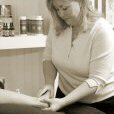About Rolfing: The Basics of Rolfing
Connective tissues within the body hold our bones and muscles in place. By adjusting these connective or myofacial tissues, rolfing properly realigns the body's posture, or structure. Research has demonstrated that Structural Integration, also known as Rolfing, creates more efficient muscle use, allows the body to conserve energy, and creates more economical and refined patterns of movement. Rolfing has also been shown to significantly reduce chronic stress and enhance neurological functioning.
Through soft tissue manipulation and movement education, Rolfers affect the body's structure and function for the long-term. Unlike traditional massage, which focuses on relaxation and relief of muscle discomfort, Rolfing is aimed at improving body alignment, balance, integration, and function. As one's body becomes more organized, chronic strain patterns are alleviated, allowing pain and stress to decrease. Furthermore, Rolfing can speed up injury recovery by reducing pain, stiffness, and muscle tension; improving movement and circulation around joints; and attending to the injury itself, plus any secondary pain or complications that may develop from compensating for an injury.
Ready to learn more about Rolfing?
- Benefits of Rolfing
- Getting Started with Rolfing
- The History of Rolfing
- Rolfing FAQ
- More Information
- Watch a video introduction to rolfing:



